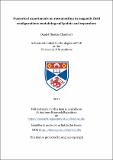Files in this item
Numerical experiments on reconnection in magnetic field configurations containing null points and separators
Item metadata
| dc.contributor.advisor | Parnell, Clare Elizabeth | |
| dc.contributor.advisor | Neukirch, Thomas | |
| dc.contributor.author | Chambers, Daniel Thomas | |
| dc.coverage.spatial | viii, 180 p. | en_US |
| dc.date.accessioned | 2022-07-21T09:02:52Z | |
| dc.date.available | 2022-07-21T09:02:52Z | |
| dc.date.issued | 2021-10-26 | |
| dc.identifier.uri | https://hdl.handle.net/10023/25676 | |
| dc.description.abstract | Magnetic fields containing null points offer favourable conditions for reconnection. In this thesis, numerical experiments attempt to gain insight into the reconnection process at these topological features. Null point reconnection is studied under the assumption that the initial state is a quasi-equilibrium. A non-equilibrium field with a current density component parallel to the fan plane is relaxed ideally to obtain the initial condition, forming fan current layers centred on the null point. Rapid reconnection occurs at the beginning of the resistive experiment, before there is a transition to impulsive behaviour. The orientation of the initial current density relative to the strongest magnetic field in the fan plane determines the current layer dimensions and also influences the reconnection rate. A single separator magnetic field is derived from the 2D Corrugated Sheet Pinch by the addition of a perturbation magnetic field. The evolution of the system is investigated numerically, using the 3D field with the pressure profile from the 2D case. The current is transferred from the original current sheet to the separatrix surfaces and null point bifurcations occur. A potential double separator field is used as the basis for a study of reconnection at multiply-connected null points. The potential field is perturbed by the addition of flux rings and ideal relaxation results in a quasi-equilibrium with separator current layers. In the resistive experiment, reconnection occurs at the centre of the separators and its effects are localised. In each of the experiments containing a single null point, reconnection occurs at current layers in the vicinity of the null. When there are multiple nulls connected by separators, the reconnection often takes place away from the nulls. However, the dynamics of separator reconnection appear to be influenced by the choice of initial conditions. | en_US |
| dc.language.iso | en | en_US |
| dc.publisher | University of St Andrews | |
| dc.title | Numerical experiments on reconnection in magnetic field configurations containing null points and separators | en_US |
| dc.type | Thesis | en_US |
| dc.contributor.sponsor | Science and Technology Facilities Council (STFC) | en_US |
| dc.type.qualificationlevel | Doctoral | en_US |
| dc.type.qualificationname | PhD Doctor of Philosophy | en_US |
| dc.publisher.institution | The University of St Andrews | en_US |
| dc.identifier.doi | https://doi.org/10.17630/sta/185 | |
| dc.identifier.grantnumber | ST/N504415/1 | en_US |
This item appears in the following Collection(s)
Items in the St Andrews Research Repository are protected by copyright, with all rights reserved, unless otherwise indicated.

